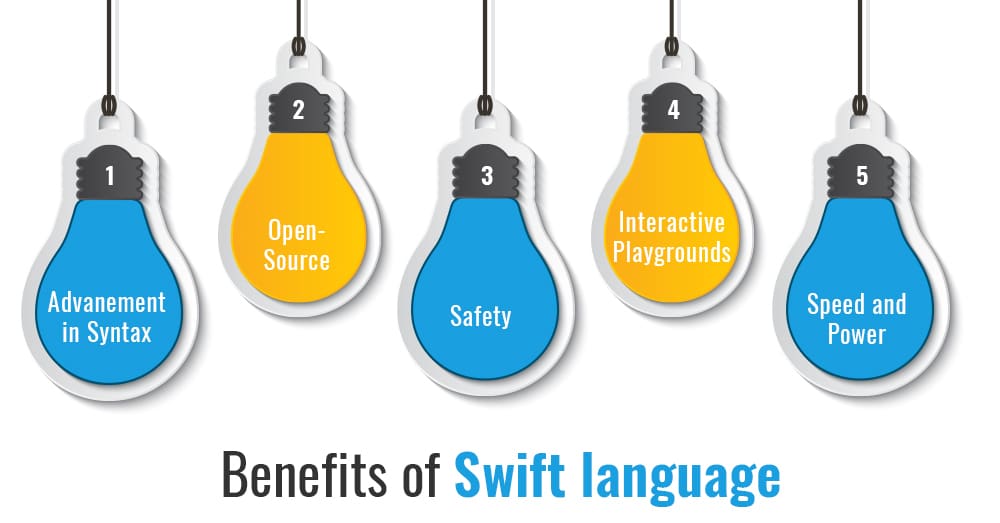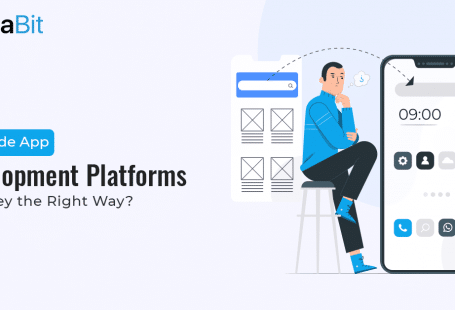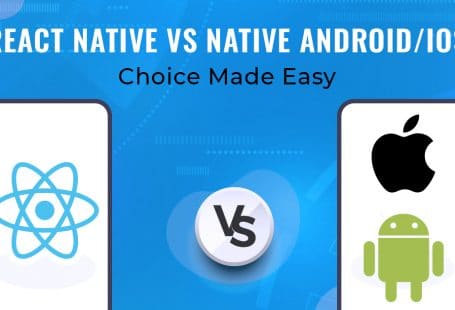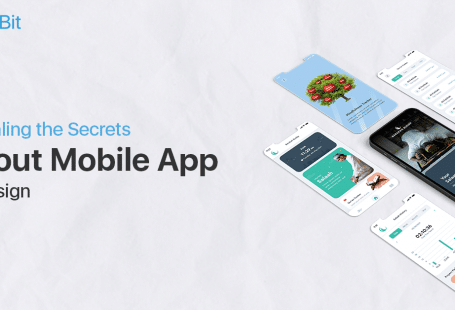
In 2014, when Tim Cook, the CEO of Apple, announced Swift’s release, he said that he believes it will be the “next big programming language” and developers globally would be using Swift for at least 20 years for every development-related work.
And what’s surprising is that he was absolutely right!
Today, Swift is not just a success story as predicted by Tim, but a language that can secure the future of iOS app development.
Swift showed its worth at the launch itself, and whatever Tim said is the launch proved to be correct.
You can check the launch video here.
Anyway, looking at Swift’s market statistics, we have come to realize that it has already acquired a significant portion of the user-base since it arrived.
However, it is essential to know why Swift has become a “hot topic” in the development world.
In this write-up, we’ll explain all that you should know about Swift and why it is the future of iOS app development.
The Introduction:
Swift is considered to be a pro-developer programming language especially designed in a way that it becomes beginner-friendly.
In fact, many developers compare Swift with the language “English.” since it is effortless to adapt to swift and begin with the coding process.
Moreover, Swift is also an authoritative and instinctive language that can be used to develop an application for all Apple products such as iPads, iPhones, Mac, etc.
Since the very beginning, iOS app developers were coding in the Objective-C language, which was, obviously, useful, but who doesn’t want better?
To quench this thirst for developing an application quickly and constructively, Swift was launched. It was designed to replace the language existing since 1984, i.e., Objective C, and it did!
What adds to Swift’s abilities is how easy it is to maintain; an application developed in Swift can automatically sense the code errors in real-time, thanks to Xcode (IDE). And of course, another significant advantage of Swift for the developers and the open-sourced nature of it.
Therefore. It is safe to say that Swift has made it convenient for iOS app development agencies to quickly and seamlessly develop a powerful iOS application for all Apple devices.
Back to the History:
The development team backing Swift started the work in 2010, four years before Apple actually launched the programming language for global coders.
As soon as the incredible language was launched, many developers quickly joined the bandwagon to try their hands on Swift’s features, including brief syntax and reduced crashes.
Swift was designed to be understood and to deliver the application with powerful features. However, many programmers considered it a natural evolution of the “earlier popular” language Objective C.
Some Facts:
- Swift’s first version was 1.0, which saw a significant upgrade to Swift 2 at WWDC 2015.
- The updated version of Swift. I.e., Swift 2.2 was released as open-source software under Apache’s license 2.0 in December 2015 for Linux and Apple’s platforms.
- When version 3.0 was released, the earlier version was upgraded with significant transformations as the full syntax changed. In just the first quarter of 2018, Swift was able to overcome the fame Objective C enjoyed.
- Later, version 4.0 was launched to integrate multiple features that allow the developer to make significant upgrades in their existing applications. The version allowed developers to upgrade the current code of previous versions of Swift via the migration functionality of Xcode.
- Now the latest version, Swift 5, brings in ABI stability and significant language improvements.
All in all, the bottom line is that Swift’s scale-up is envy-worthy. The programming language has made its way into every iOS app development agency’s lives and is one of today’s most preferred development languages.
What’s more to Swift?
The Top Features it Has:
- Open-Source:
The team backing Swift development is the developers at Swift.org, a wholly dedicated website to the open-source community of Swift. It is integrated with a bug tracker, source code, mailing lists, and other standard development lists.
The organization that launched Swift also allowed it to run on Linux with a specific version with a toolset dedicated to swift development.
The toolset comes with the LLDB debugger, package manager support, and REPL. Swift allows programmers to develop iOS, watchOS, tvOS, and OS X applications, although it can only function on Mac.
In simpler words, Swift is what you need if you wish to develop your iOS application safely and quickly while enjoying the process throughout.
- Advancement in Syntax:
The new syntax features of Swift allows the developer to write more expressive codes. The SDK in the updated versions uses new Objective-C features, including generic explanations and null-ability for code safer and cleaner.
- Safety:
Swift can effectively remove the entire group of unsafe codes. For instance, variables are initialized prior to implementation, integers are inspected for overflow, and the memories are managed automatically.
Another advantage of using Swift is that the objects in it are never zero, that means as soon as a programmer enters bad code, the language produces a compiler error.
Therefore, the issue can be resolved as soon as the wrong code is entered, thus decreasing the amount of time, effort, and money you invest in your iOS app development.
Lastly, it can trigger a runtime crash when a NIL optional variable is used; this will, in turn, evade the bug or fix it sooner wholly in the swift code.
- Interactive Playgrounds:
A great benefit to Swift developers is its playgrounds. They allow the developers to run their algorithms and graphics tests without building up an entire iOS application.
Apple has also integrated swift playgrounds with an inline code execution allowing coders to write an algorithm or a massive number of codes while obtaining continual feedback along the way. The feedback loop here boosts the speed of writing codes for the application.
They can also include comments in bullet lists with added links and images.
- Speed and Power:
Swift had drastically improved when it integrated legacy C conventions. It provides a remarkable performance to your iOS application via the LLVM compiler that transforms the swift code into a native code that is fully optimized.
Swift has allowed faster and more superb performance than python since it has made object categorization simpler. It offers the coders incredible object-oriented features such as protocols, classes, and generics that provide the Cocoa and Cocoa Touch developers the performance and authority they desire.
These features serve as benefits to any entrepreneur who decides to perform iOS app development with Swift.
Some More Benefits the Language Offers Are:

- Shorter development time:
Developers worldwide prefer choosing a language that can be easily understood without much complexity. And Swift provides a seamless development experience since it consists of cleaner syntax, making the process of writing, reading, and modifying a lot easier.
A developer would have to write fewer code lines to execute an option. This can help the coder get rid of the legacy conversions. As we mentioned before, it is compared with plain English since the method is a lot more convenient and simpler to understand and implement.
Hence, an entrepreneur can save up both money and time, and what’s more? The development process is fun too.
- Easy to Maintain:
Developing and launching an application is not the end of a long hectic process. You will have to keep your website up to date so that users can get the best experience while navigating.
While using Objective C, the programmers would have to sustain two codes if they desire to improve the code’s efficiency. But that’s all in the past since Swift is here to combine (.h) and (.m) files into one single (.swift) file.
- Experiment Possibilities:
Swift offers a playground mode, which is highly advantageous for iOS app development agencies and developers to test out the new and modified features that are to be integrated into the application.
These playgrounds make the update process a lot more accessible since the developer can get a clear picture of how the app would look once they move further with the development process.
It also supports multiple dynamic libraries. These include the executable code that can be linked to an app. In simple words, the current Swift application can connect to the newer versions as the language grows.
Reasons Making Swift the Future of iOS App Development:
Some reasons why Swift is definitely the future of iOS app development:
- Easy to Read:
Swift is an “easy to adapt” language. Developers, even beginning with their careers, can test their abilities using Swift. Since it is similar to plain English, it is easier for programmers who deal with C++, C#, Java, JavaScript, and Python to use swiftly to develop their iOS technologies.
- It is safer:
An exciting characteristic of Objective C is how it handles the pointers- especially nil (null) pointers. Objective C doesn’t bring anything to you when you call a pointer via a nil pointer variable.
This line of codes or expression becomes a no-op (no-operation), and while it is a bit useful since it doesn’t crash, it has still been a gateway for bugs. A no-op initiates random behavior, which proves as a hurdle for programmers trying to find and fix an irregular behavior or a crash.
- Requires less code:
Swift drastically decreases the coder’s load by reducing the need to write repetitive statements and string manipulation.
To join two pieces of information, Objective-C would require the programmer to take way too many steps to work his way with text strings.
Swift comes with modern features like adding two strings utilizing the “+” operator, which is missing in Objective-C.
Any programming language needs to support joining strings and characteristics for the app to display the text on the user’s screen without much trouble and disparity.
Parting Thoughts:
It is evident that Swift is the future of iOS app development, and indeed, Tim Cook was correct with his statements at the launch. The incredible functionality and ever-growing features prove that Swift is here to stay, and its use will continue to be useful in developing secure and high-performing applications.
The fact that it is being utilized by Apple’s opponents as well, thus it is a clear indicator of the power this programming language holds.
Moreover, the benefits it offers are too hard to ignore. Therefore, you can expect to see Swift reaching even greater heights soon.







